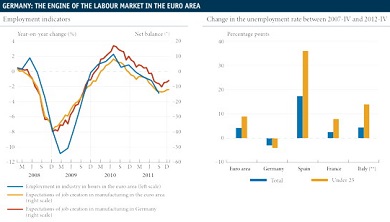2013 has started with slight signs of a slowdown in the rate of job losses in the euro area thanks especially to Germany’s good performance. This stabilization of the labour market is in line with the interpretation of activity indicators overall, which suggest the intensity of the economic crisis might be easing.
In fact, the index of the European Commission poll in January on expected demand for labour in the services sector over the next three months improved by 0.3 percentage points up to a negative value of 5.2, a smaller contraction than for the fourth quarter as a whole. An improvement can also be observed in expectations to hire in retail trade and, to a lesser extent, in manufacturing. January’s figures therefore point to a change in trend, in line with the sharp rise in the PMI the same month.
Similarly, in December the unemployment rate held steady at 11.7% for the third consecutive month, showing signs of stabilizing, which might have helped to improve consumer confidence in January and February. Nonetheless, the unemployment rate was one percentage point higher than the figure recorded in December 2011.
The trend in the labour market during the crisis masks huge discrepancies between the different groups (see the graph below). Young people have been hit particularly hard. In the euro area, the unemployment rate for this group reached 24% in the last quarter of 2012, close to nine percentage points above the rate recorded at the start of the economic recession. However, both the figure recorded in the fourth quarter and its trend over the last five years were highly disparate between countries. While the under-25 unemployment rate fell by 3.5 points to 8.0% in Germany, in Spain this increased by 36.2 points to 55.4%.
High youth unemployment is worrying as this is one of the groups at the greatest risk of social exclusion and the European Union has therefore put helping this group at the top of its list of priorities. In fact, the proposed European Union budget for 2014-2020 was presented at the European Council on 8 February and this agreed to allocate 6 billion euros to support those regions whose youth unemployment rate is above 25%.







Be the first to comment on "The deterioration in the labour market may have bottomed out"